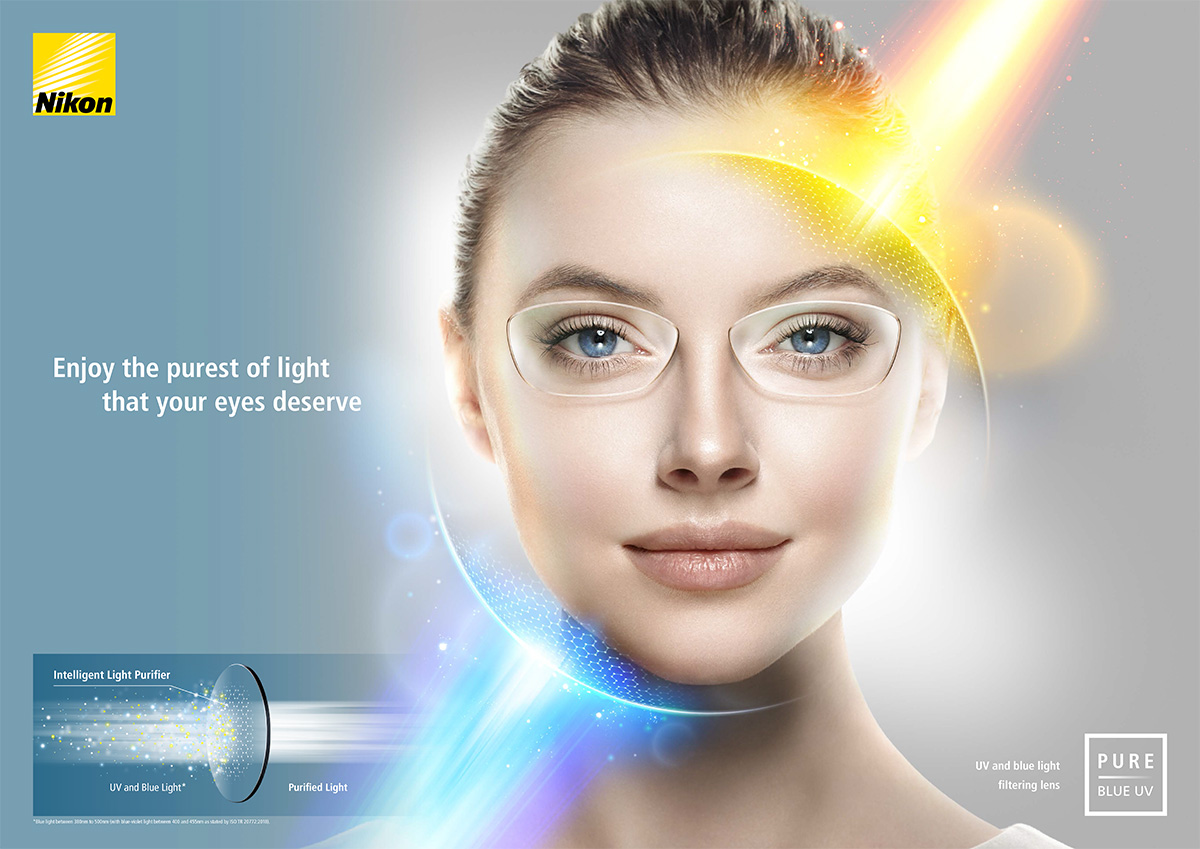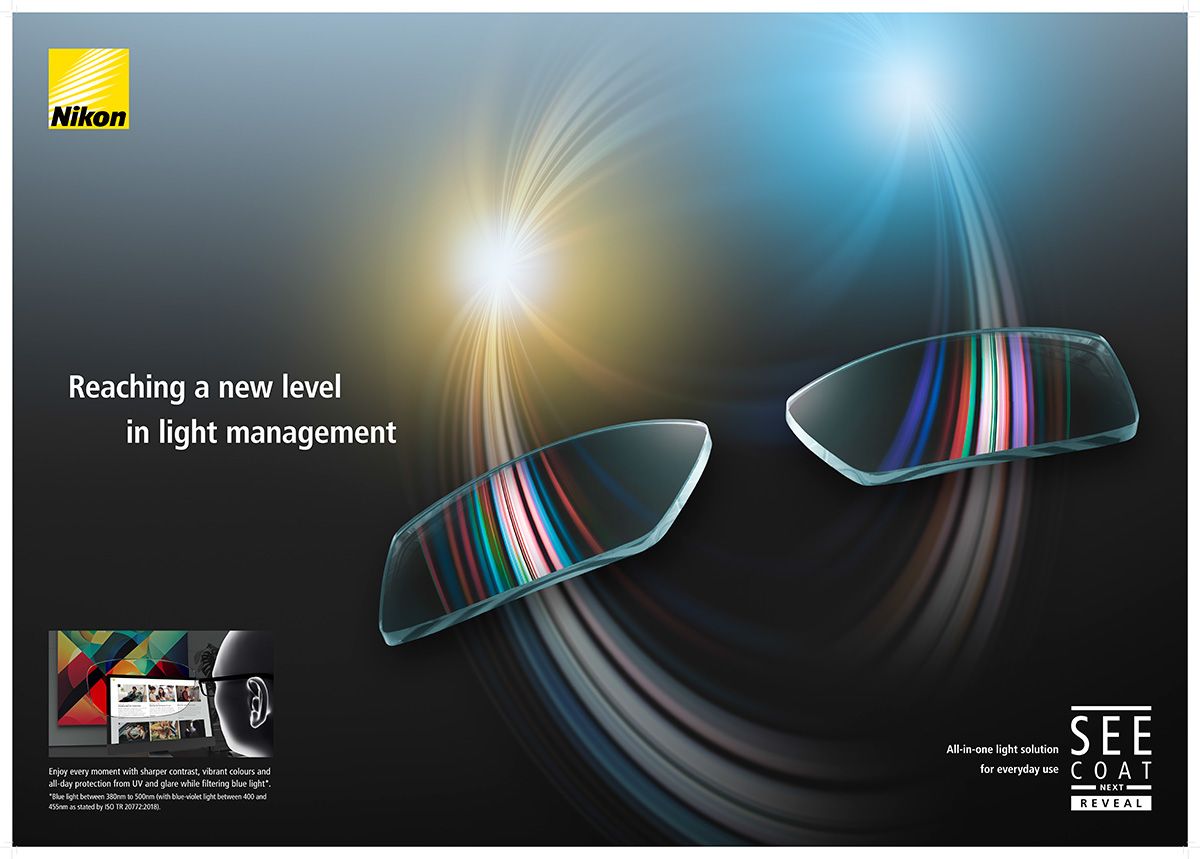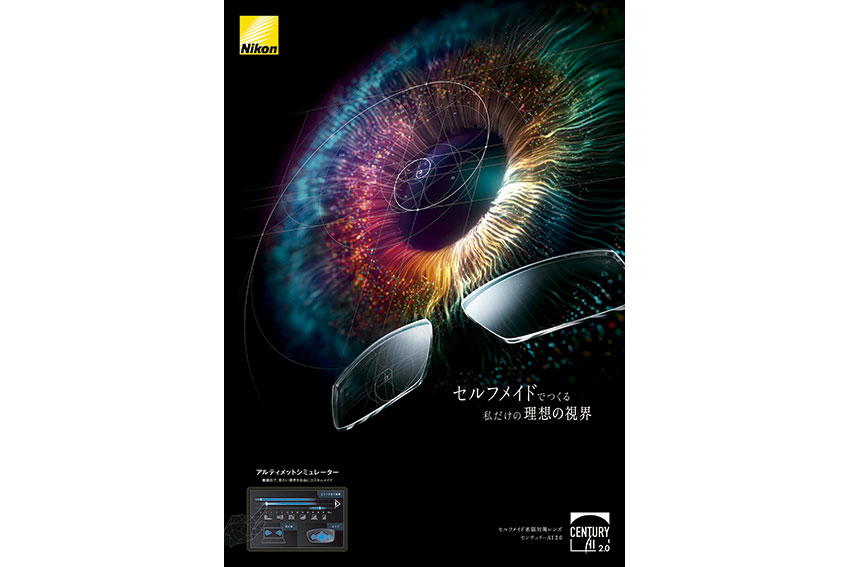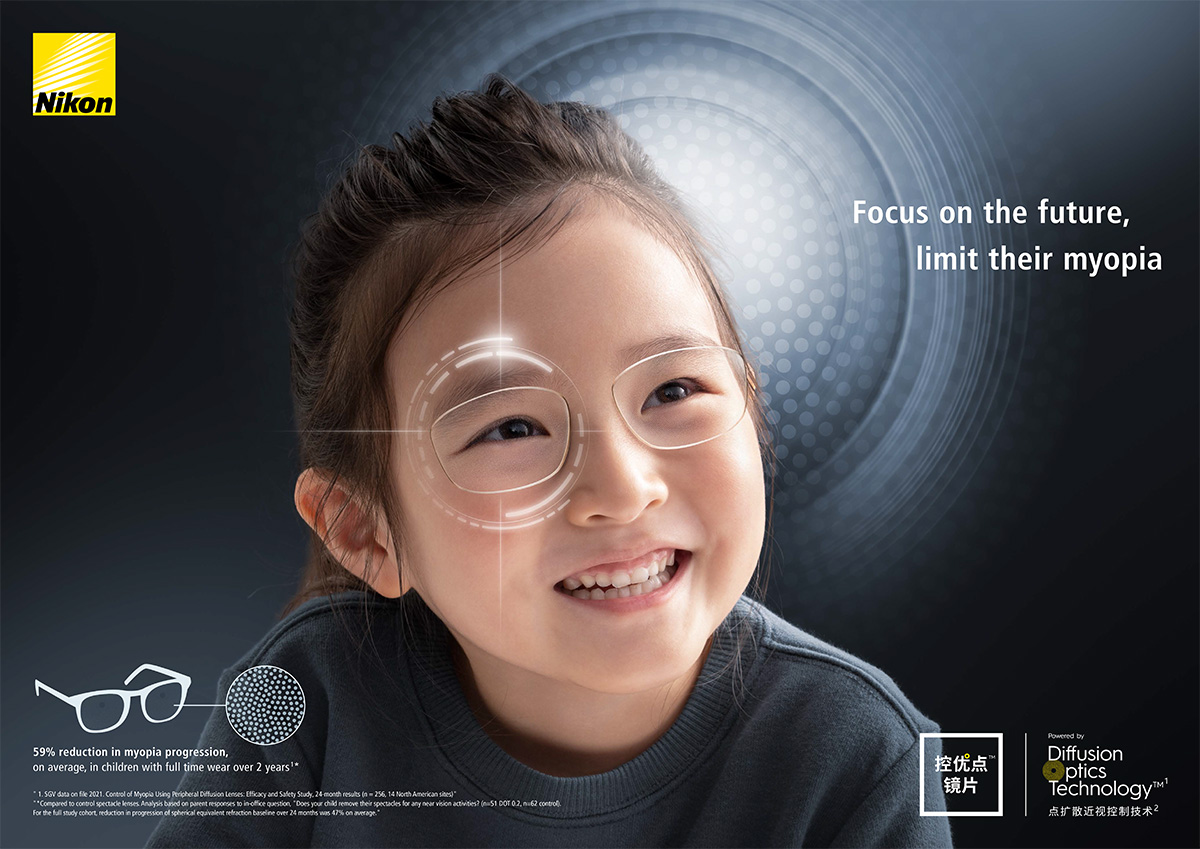Nikon's custom-made eyeglass lenses are designed after receiving individual orders and provide the optimum viewing comfort that matches the customer's lifestyle

Japan’s aging society is putting a lot of stress on public finance and health care, inspiring a shift from a treatment model to a preventive health care model. If we talk about visual disorders, wearing the correct lenses can prevent degenerative visual conditions from worsening as well as save costs down the line. How is your firm tackling the Japanese market and adapting to this shift from treatment to prevention?
This is an important question. You mentioned the burden on society with the aging population and I think this is spot on. Japan has an aging population but we can also observe an increase in life expectancy all across the globe. In addition to that, people are being exposed to longer screen times than ever before and this has been exacerbated further by the COVID-19 pandemic with people spending more time at home. All these factors are significantly contributing to an increase of the population daily eyes solicitation and therefore vision care needs.
In your question, you mentioned increased public costs. If it is right in many countries, I think Japan is in a slightly different position because eye care here is largely funded by the population itself. Eyeglasses are paid out of pocket with almost zero public funding and very limited private insurances. To that end, we cannot say that today it is a direct burden on public finance. However, I agree with your analysis regarding the importance of prevention as it can help us to avoid significant future costs. Consequently, given the growing importance of the eye care concerns for the population and the very positive impact of prevention, I would not be surprised to see an increasing interest from the public authorities and private players in this health area.
If you do not mind, I would like to elaborate a bit further. In the mindset of the population, glasses are considered as a very efficient way to correct vision with – as we say when we talk about health products –an indisputable therapeutic value! They are fantastic products to treat refractive errors and fix vision distortion with almost 100% of success.
However, thanks to decades of innovation, beyond the ability to bring clear vision, the lenses also became over years one of the best way to protect our eyes in the long term. Each of us is more and more exposed in its daily activities to harmful light, starting with ultraviolet. UV can affect vision health in the long run -as it can affect the skin- increasing the risk of cataracts as well as other diseases. And, on the contrary to a common preconceived idea, UV rays are not only present outdoor during sunny days! To that extent, the lenses could bring an opportune and efficient protection throughout the day, the season and the year. The blue violet light* is also another area of vision care concerns. In that case, lenses can play a positive role by filtering the 400-455 nm light wavelengths. With these two example, you can see that a lens, beyond correcting vision, can also protect the eyes by filtering the light rays that can reach the eyes. At Nikon-Essilor, we relentlessly pursue these objectives when we imagine and develop new lenses.
This is especially important now considering the long-life expectancy. Babies now being born are expected to spend at least 100 years on this planet! It is fantastic…as long as they can live their extra years in good health. You know, at birth, we receive one set of eyes for our entire life and we know that from our 50’s, the visual capacity starts to decline noticeably. This is one of the challenges of our industry, and a key research axis for Nikon-Essilor. Because, back to your initial question about the public cost, if in our advanced age, we cannot take care of ourselves, get around independently or communicate with others, then we can become a huge burden for the society. In short, at Nikon-Essilor, one of our ambition is to help the population to have their eyespan matching their lifespan.
As a company that produces eye-related medical care devices, what role can you play in communicating the risk and severity of eye disorders to the public?
It is definitely part of our duty, but at the same time, we do not want to focus too much on the negative points. It is definitely great to live for a hundred years and we can be very delighted about the progress in medicine, which made it possible!
Our job is first to make sure that we develop innovative and disruptive solutions to allow everybody to enjoy his or her life at its fullest and embrace the future without any compromise.
Nevertheless, you are right, it is also important to raise awareness about good vision among the population and the decision-makers. Of course, we cannot do this alone: we also need the ophthalmologists, the opticians and the health agencies’ voices if we want to give rise to a dynamic and sustainable vision care ecosystem, up to the society challenges.
If we all work together and join forces, no doubt that we can design a bright vision care future for the population, without costing one additional JPY of public money and avoiding huge costs in the long term. In many countries, this kind of collaboration already exists around one ambition: improving sight is good way to improve life. A question I often raise to our partners is: “If we don’t do it, then who will? I have the conviction that, together with the ophthalmologists, the eye doctors, the opticians and our colleagues, we are the ones who can change this trend for the good of the population.
Your company is a very interesting case being a joint venture of a Japanese firm and a French firm that has over 20 years of history. What benefits do having this history and structure bring to being able to develop the kind of ecosystem you’ve mentioned today? What are the key lessons you’ve learned over the 20 years you’ve been a part of this joint venture?
To make a long story short, I would say that we benefit from the best of two worlds. Nikon-Essilor is the daughter company of two giants of our industry, two giants when it comes to optical expertise and light management. On one side, we have EssilorLuxottica, the global and pioneering leader when it comes to ophthalmic lenses, frames, sunglasses with advanced technology, iconic eyewear, retail expertise and world-class instruments. On the other side, we have Nikon Corporation, a fantastic and inspiring Japanese company, renowned worldwide for its innovation power, its loved brand and its unique expertise in imaging, precision equipment, digital manufacturing or healthcare products.
As a joint venture between the two, we can benefit from the savoir-faire of both companies, leveraging both cultures and best practices, mixing if I can say, the Japanese Kiwami (ultimate) with the European pragmatism!
Our two parent companies are massively investing in innovation and our own engineers in our R&D hub in Kanagawa Science Park are in constant connection with them and also run direct collaborations with academic institutions and other industry, such as chemical.
Obviously, there is a lot of overlap between the two giants you stand between, and I think it has allowed you to develop some of the disruptive solutions you mentioned, and those can really make a big impact. One of them is your Pure Blue UV technology, which won the Good Design Award in 2020. Could you talk a little about the development history of this technology and some of the treatment options for blue light? How can your products and technologies limit peoples’ exposure to blue light?
We like pioneering. As an example, when we launched our first blue violet* filtering Rx lenses in 2011, SeeCoat Blue, it was a first in the world. Now, globally, about 20% of the lenses sold provide this feature.
As said earlier, modern life requires always more from our eyes: they are constantly changing focus, direction, multitasking, moving from one screen to another one permanently…As for SeeCoat Blue, to put it simply, we tried to control the light through the lenses, allowing beneficial wavelengths through while filtering blue violet* light. That was the overall concept. However, as we know, innovation always balances between radical and incremental and we capitalized on these first learnings and wearer’s feedback to launch, a few year later, a second generation. The latter was able to generate much less blue reflection on the surface of the lenses, improving significantly the aesthetics. Then came, the third generation, the one you mentioned, Pure Blue UV, which leveraged both our blue violet* filtering and UV cut technologies.

Pure Blue UV key visual
This year, last April, as a preview showing, we launched in Japan our 4th generation of this technology: SeeCoat Next Reveal. This ultimate lens retains the best features of Pure Blue UV but take the light wavelengths management to the next level, enabling brightening effect and contrast improvement. This is especially impressive indoors and in dim light conditions.
Let me open a parenthesis here: we discussed earlier about some vision care pre-conceived ideas in the population. There is another one when it comes to eyes protection: many consumers are still mixing up the darkness of a lens, its antiglare effect, with its protecting power. Actually, a clear lens like SeeCoat Next Reveal can provide a better protection than a poor quality sunglass, it depends on both features. This launch gives us the opportunity to keep raising the awareness of the population about good vision and refuting some hazardous misconception.

SeeCoat Next Reveal key visual
What changes did the COVID-19 pandemic have on your company in terms of R&D? What mid to long-term changes did you have to make?
Before I get to the R&D part, I would like to truly thank our customers and partners who remained faithful during this tough covid period and our team who carried out the feat of managing our supply chain without interruption. You know, the lenses are by nature tailor-made products, products of mass consumption but designed and manufactured individually. I am not sure there is an equivalent: around 5 billion people around the world need glasses and each of them have specific and unique needs…for both eyes!
Consequently, we cannot just have a big factory pushing out uniform products; it simply does not work like that! In fact, it is the opposite of off-the-shelf products. In most of the cases, the lens does not exist before the patient meets an eye care professional who is able to take the proper measurements and make the right recommendation. In this pandemic time, despite the flows complexity and thanks to the network of laboratories we have all across the world in coordination with EssilorLuxottica, we were able to keep producing and delivering lenses to our customers.
To answer more your question about the pandemic impact on our research axis, let me give you a concrete example. One of the first product we developed after the covid outbreak was an antifog and anti-bacterial lens! While wearing a mask all the day long, many consumers complained about the mist that came up on their lenses and express concerns about possible bacterial risks. Some people might laugh, but it was a real concern for many users and therefore we launched Dual Safe View in 2021.
During this period, as usual I would say, innovation was not only about products. We also helped our partners to adapt their shop protocol for the lens dispensing with the new social distance rule. Some people were afraid of meeting face-to-face, so we brought new measurement ways, special sanitary guidelines as well as social media kits and posters to communicate proactively to their patients. To bring you more colors about this change, in our flagship store in Tokyo, Nikon Megane, we set a new eye examination room enabling a remote measurement with the patient and the staff separated by a glass door. Since then we have applied this new set-up to several other locations, and where we could not do that, we offered customers online appointment tools to manage the flow of people in the shops.
Talking specifically about products, from 2020, we have developed new lens designs, in particular for presbyopic people, taking into consideration the development of work from home practice and the increasing time spent in front of screens. As you may know, as we get older, our eyes progressively lose their ability to focus near distance and we need the support of a lens to compensate. Progressive lenses provide additional near viewing power while ensuring a clear intermediate and far vision, which allows the wearers to exert less effort to see clear. In the recent years, we developed dedicated indoor designs for work or reading activities (available in the Century AI and Lohas series). This means that compared to the regular progressive lenses, the wearer would have more room in the vertical axis of the lens dedicated to the viewing of a computer or a smart device.
This open the box of another preconceived idea we need to tackle: the adaptation issues some wearers used to face more than 50 years ago with the progressive lenses do not exist anymore! Today, thanks to decades of relentless innovation, these lenses are the best solution to address the presbyopia challenge and therefore maintain a sharp, clear and natural vision after 45 years old.
In Japan, the senior population segment is quite big; however, because of this persistent misconception, the proportion of these people who resort to progressive lenses is much lower than in many comparable countries. Let’s turn back the clock: Essilor launched the first progressive lens in 1959, it was the birth of Varilux. It was a big scientific challenge and an amazing disruption at that time to manage a power progression in one single lens. Since then, benefiting from many innovations and physiological discoveries, generation after generation, the product improved drastically and offer now a perfect vision to any wearer.
I like to say that if historically, the wearers had to adapt themselves to the lens design, today it is the lens, which adapts itself to the wearers’ individual visual needs and lifestyle. At Nikon-Essilor, to make it possible, we can rely on proprietary technology and in particular our unique and powerful calculator, Nikon Optical Design Engine, that able us to factor multiple individual factors in the lens design and therefore to meet the exact needs of each single wearer. In that area, Century AI 2.0 is the most sophisticated and personalized Nikon progressive lens we have ever imagined and conceived.
You mentioned Century AI 2.0. Can you explain more about it?
I told earlier that a lens is an individualized product. The basic level of personalization is your refractive error: are you nearsighted, farsighted and/or astigmatic? At what level? The second level is the fitting: what is the lens distance from the pupil, the tilt angle, the frame shape, its size, etc.? Third level: since your image perception involved also your brain analysis, what is your individual's sensitivity to key factors, like the blur for example? The fourth layer is related to your personal lifestyle: what are your favorite activities? What distance you need to see clear? Etc. When you start to combine these parameters, there is no way that you can have predetermined data points and every order we receive triggers individual calculations one by one, here in Japan, via our Nikon Optical Design Engine. For the consumers, these bespoke lenses are the best guarantee of a perfect quality of vision.

Century Ai 2.0 Key visual
Bespoke is a good way of putting it because each lens is tailored not just for each set of eyes, but the lifestyle led by each user. That level of detail is incredible and there are so many factors you need to take into account. Century AI 2.0 is gathering data and using this model to prescribe bespoke lenses. What kind of role do you believe this kind of digital technology can play in both the diagnosis and treatment of eye conditions?
The digital technologies are critical for us and it is a major area of investment. Of course, they are very helpful in our manufacturing processes but they are instrumental too in the eyes measurement at the shop level.
At our flagship store in Tokyo, Nikon Megane, we are capable of taking measurements at a level of 0.01 diopter of precision, while it is usually a quarter of diopter. Needless to say that having your exact prescription can make a big difference!
The digital technologies can also be very useful when it comes to sight simulation. Traditionally in a shop, it might be difficult for the patient to understand what he or she will get and see at the end of the process since the lenses do not exist yet. With the digital simulation, we can make this process an easy to understand and immersive experience.
As you mentioned, lenses are a medical device that is clear, which obviously poses some challenges when it comes to automating visual inspection and quality control. How have you approached that challenge? How are you able to automate the inspection of a transparent product with consistent quality control?
That is true: by nature, a lens look like a very simple product because of its required transparency. However, as you pointed it out, it is in realty a concentrate of invisible high technology. It is not easily perceptible at a glance but the differences from one lens to another one are huge! Therefore, before shipping the products to the eye care professional, we carefully check both their aesthetics and their optical performance. Of course, it is quite complicated and part of our trade secret but we have developed in-house expertise, process and machinery to ensure we always reach our high standards on both aspects.
Today we have talked a lot about the developed world, but not so much about the developing world. There is a considerable number of elderly people in developing countries who have or are developing degenerative visual conditions. On the other hand, we are also seeing many young people experiencing the onset of conditions like myopia. As you mentioned the difficulty of access is an issue, are there any countries or regions moving forward where you would like to increase your presence and provide your products?
Yes, this is a very important topic for us. Beyond developing ultimate lenses, it is also our duty to ensure everybody can find a solution to treat its refractive error, whatever the place he lives in and the budget he can allocate. It is so important for the people but more broadly for the entire society. If Nikon Lenswear designs and delivers probably the most premium products in the world, at the same time, we support and contribute to the objective of our parent company EssilorLuxottica to eradicate poor vision at the global level by 2050. It goes through numerous initiatives from access improvement to innovation at the bottom of the pyramid via vision health advocacy.
As you put it, myopia rapid expansion among the youg population is another challenge at the planet level, as we know that it can come with serious health complications. At Nikon Lenswear, we have developed, a few years ago, a first solution for myopia called Nikon Lite DAS (Double Aspheric) which represented a big step forward in terms of aesthetics and effectiveness.
More recently, thanks to EssilorLuxottica and massive R&D investments, two disruptive technologies came up to slow down the kids’ myopia rapid progression. The first one is the HALT technology (Highly Aspherical Lenslet Target) sold in a few markets under the product name Essilor Stellest. The second one is the Diffusion Optics Technology (DOT) developed by a company called Sight Glass Vision. We have embarked this latter technology in the Nikon DOT range that we just launched in China. Both seem very effective to slow down the myopia progression and tackle this emerging “pandemic” which, based on the current prevalence rate, is expected to affect more than half of the world population by 2050 (against 27% in 2010).

Nikon DOT Key visual
Imagine that we come back again on the very last day of your presidency and have this interview all over again. What goals or dreams do you hope to have achieved by the time you are ready to hand the presidency over to the next generation of Nikon-Essilor executives?
Well, tricky question, there are so many goals! As we discussed today, Nikon-Essilor is part of a fantastic industry, an industry that is essential for the population, an industry at the crossroads of many mutating sectors, such as AI technology, healthcare, digital, retail and fashion, an industry that can and must play a growing and positive role in the society. If collectively, we do the right things, I have no doubt, that we can really change people’s lives whatever the challenges ahead…in developed and emerging countries!
Back to your question, my wish is to make sure that Nikon-Essilor brings its fair contribution to this collective and large transformation under way. With everyone’s good will, by leveraging our unique assets, our parent companies incredible strike forces and our passionate people, we have definitely everything in our hands to turn this ambition into reality. So, let’s think big and dream bigger!
*Blue-violet light is between 400 and 455nm as stated by ISO TR 20772:2018
0 COMMENTS